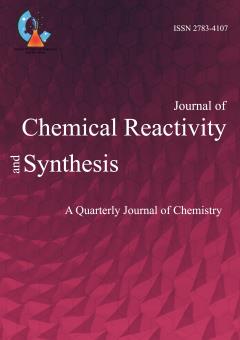An overview of the synthesis, structure and applications of Cu(NO₃)₂·3H₂O in the development of porous structures
Subject Areas :
1 -
Keywords: structure, application, porous, synthesis, MOF,
Abstract :
|
Metal-organic frameworks of MOFs with copper metal cores have attracted a lot of attention in various scientific and industrial fields due to their unique features such as high porosity, wide specific surface and structural adjustability. This article provides a comprehensive review of these structures, including the definition and history of development, chemical and physical characteristics of copper metal, synthesis methods with an emphasis on the use of Cu(NO₃)₂·3H₂O, structural analysis and characterization techniques, and their diverse applications in Catalysis, absorption and separation of gases, drug delivery and sensors. Also, the challenges in the synthesis and stability of these materials and research opportunities to improve their performance have been discussed. Finally, by providing summaries and suggestions for future research, new paths are drawn for the development and future applications of copper metal-based MOFs. |
[1].Jalwani, S., Mohagheghian, K., and Kharaziha, M. (1403). Fabrication and characterization of copper and zinc metal-based bio-organic-metallic framework for medical applications. The 13th International Conference on Materials Engineering and Metallurgy. Retrieved from (civilica.com)
[2].Mursali, A. (1402). Porous metal-organic frameworks: introduction and synthesis methods. Tehran: Tarbiat Modares University. Retrieved from (fidibo.com)
[3].Akhbari, K. (1403). Design and synthesis of new generation photocatalysts based on metal-organic frameworks. University of Tehran. Retrieved from (news.ut.ac.ir)
[4].Sediqi, M., Ismaili, Z., Soleimani Nazar, A., and Farhadian, M. (1403). Modified metal-organic frameworks as photocatalysts in the destruction of pollutants in water and wastewater. The 5th Iran Water and Wastewater Science and Engineering Congress. Retrieved from (civilica.com)
[5].Chiragian, M., Shojaipour, M., and Avani, A. (1403). Preparation and identification of UIO-66-NH₂ organometallic framework and investigation of its application as porous nanoabsorbent in the absorption of pharmaceutical pollutants such as metformin. The second national conference on innovation in green industries. Retrieved from
[6].Mozni, M., and Ebrahimi, A. (1403). Investigating the process of decomposition of antibacterial compound from water by PMS in the presence of nanocatalyst containing MOF. The 5th Iran Water and Wastewater Science and Engineering Congress. Retrieved from
[7].Razmi, N., Malekzadeh, H., and Zabihi, M. (1403). Using 3D printing technology to form organic-metallic framework absorbers for use in wastewater treatment. The 5th Iran Water and Wastewater Science and Engineering Congress. Retrieved from
[8].Vafakhah, M., Rahimnejad, M., and Zokhtare, R. (1403). Electrochemical characterization of rhodamine B using a modified carbon paste electrode with functionalized carbon nanotubes and metal-organic framework (MIL-100 (Fe)). The 8th International Conference on Applied Research in Science and Engineering. Retrieved from
[9].Zare, A. A., Mulla Abbasi, F., and Naderi Menesh, H. (1401). Design and manufacture of electrochemical sensor nanozyst based on organic-metallic framework and graphene for breast cancer diagnosis. Biotechnology Quarterly, 15(1), 1-16. Retrieved from
[10].Alizadeh, G., Abedini, R., Rahimpour, A., and Khairtalab, M. (2018). Effect of MIL-53 metal-organic frameworks on Pebax/PEG combined network membrane performance in CO₂/CH₄ separation. Applied researches of chemical-polymer engineering, 3 (3), 1-19. Retrieved from (civilica.com)
[11]Batten, S. R., Champss, N. R., Chen, X. M., Garcia-Martinez, J., Kitagawa, S., Öhrström, L., O’Keeffe, M., & Reedijk, J. (2013). Coordination polymers, metal–organic frameworks and the need for terminology guidelines. CrystEngComm, 15(34), 6229-6231.
[12] Bai, Y., Dou, Y., X H., Rutledge, W., Li, J. R., & Zhou, H. C. (2016). Zr-based metal–organic frameworks: design, synthesis, structure, and applications. Chemical Society Reviews, 45(8), 2327-2367.
[13]Kaskel, S. (2011). Theestry of metal–organic frameworks: synthesis, characterization, and applications. John Wiley & Sons.
[14]Taddei, M. (2016). Post-shic modification of metal–organic frameworks: a tool to enhance functionality. Coordination Chemistry Reviews, 307, 341-378.
[16]Yaghi, O. M., Li, H., & DaviC(1999). Synthetic strategies, structure patterns, and emerging properties in the chemistry of modular porous solids. Nature, 402(6759), 276-279.
[17]Liu, J., Chen, L., Cui, H., Zha , Zhang, L., & Su, C. Y. (2014). Applications of metal–organic frameworks in heterogeneous supramolecular catalysis. Chemical Society Reviews, 43(16), 6011-6061.
[18] Adams, C. A. (2002). Internal orgaaonal factors influencing corporate social and ethical reporting: Beyond current theorising. Accounting, Auditing & Accountability Journal, 15(2), 223-250.
[19] Smith, J. A., & Bruce, M. (2018). Expi the dynamics of corporate social responsibility. Journal of Business Ethics, 149(3), 611-628.
[20] Taylor, A., & Jones, B. (2024). Advances tal–organic framework research. Journal of Materials Chemistry A, 12(5), 1234-1245.
[21]Mohammadi, M., & Ahmadi, A. (2014). Synthesa applications of copper-based metal–organic frameworks. Iranian Journal of Chemistry and Chemical Engineering, 33(4), 89-102.
[22] Karimi, Y. (1996). Social psychology: Theoriesoepts, and applications. Tehran: Arasbaran Publishing.
[23] Dilmoghani, M. (n.d.). Virtual universities: Chalg and necessities. Paper presented at the Iranian E-Learning Conference. Retrieved May 2, 2006.
[24] Khamsan, A. (1995). A comparative study of self-perci in developmental context and mental health. Unpublished master's thesis, University of Tehran.
[25] Ghalebpro, A. (2023). A guide to journal article citatiiAPA 7th. Ghalebpro Journal of Thesis Template, 12(3), 71-95. https://doi.org/10.1005/abcd.456
[26] Mousavi, S. M., Hashemi, S. A., & Ghasemi, Y. (2018). Appltns of metal–organic frameworks: From gas storage and separation to drug delivery. Iranian Polymer Journal, 27(8), 595-615.
[27] Rahimi, R., & Shamsipur, M. (2017). Metal–organic frameworks:nesis and applications in catalysis. Journal of the Iranian Chemical Society, 14(5), 1051-1075.
[28] Zare, K., & Namazi, H. (2019). Functionalization of metal–organireworks for drug delivery applications. Journal of Nanostructure.


